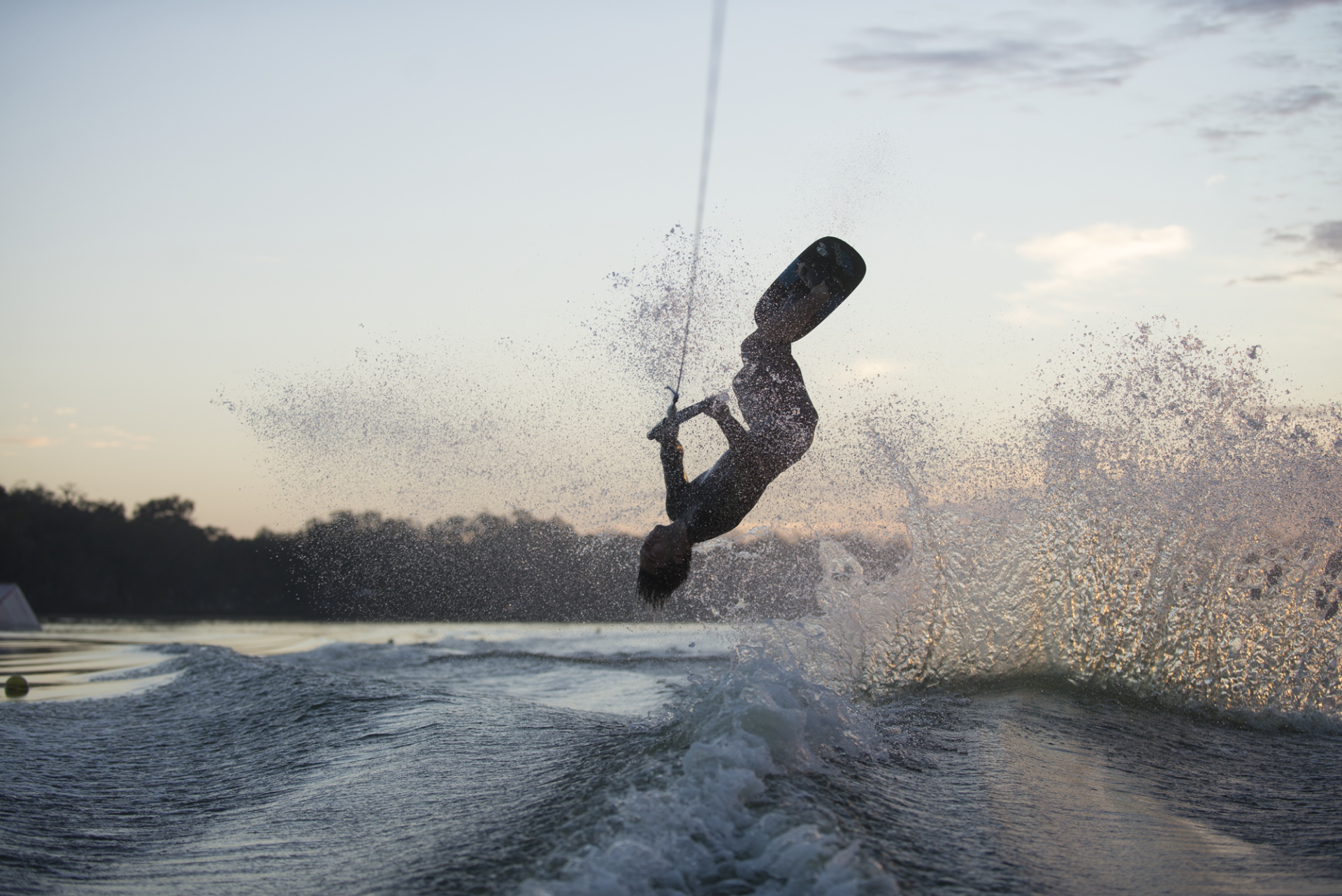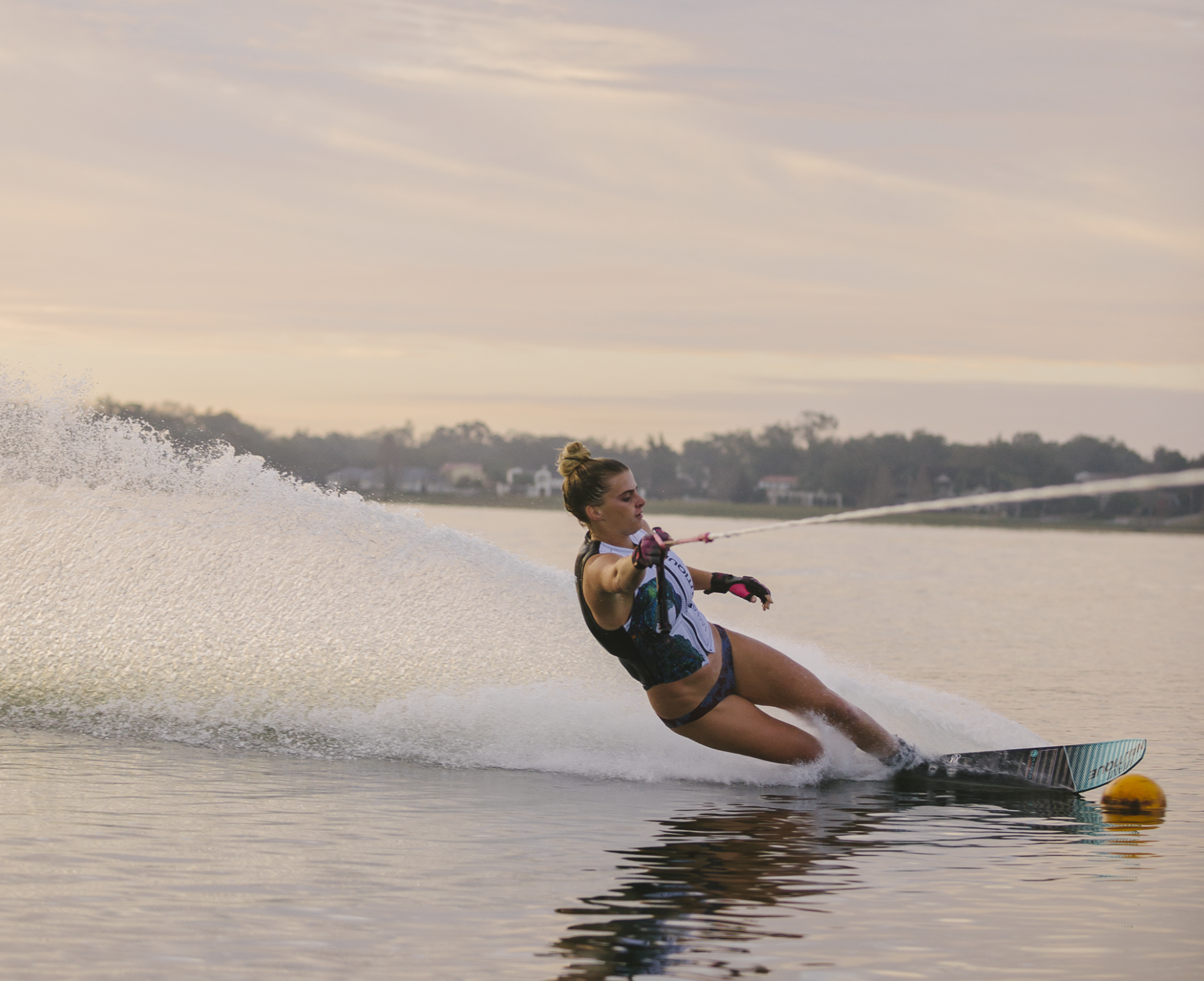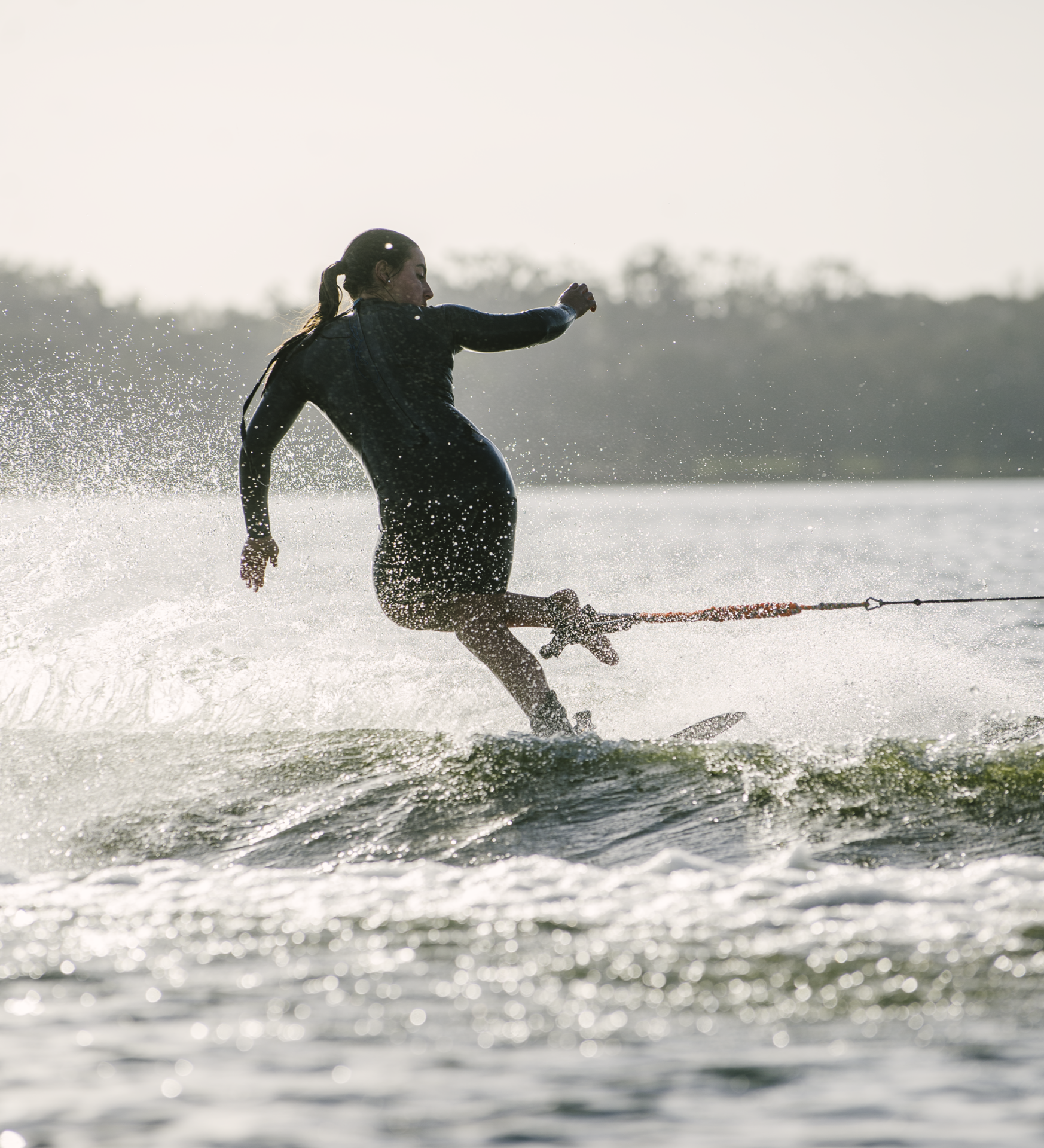Even when the waters are a tad choppy, skiers are ready to jump in. At first light, if conditions are favorable, Florida Southern College Water Ski athletes are ready to make some waves. For a Division II school to have made their way to competing in Division I, clearly this team is well-versed in handling the water … though much credit may be due to its full-time coach, something few ski teams have the luxury of. Since the arrival of Coach Curtis Rabe, the team has gained immense traction in the sport. While it may not garner the limelight of collegiate sports as some do, it certainly takes skill, never mind some guts, to ride the water.
Photography by Jason Stephens
The Lakelander: Water skiing must be the quintessential Florida college sport, but it flies under the radar compared to other college sports. Tell us about its size and impact.
Curtis Rabe: Collegiate skiing is huge. But, you’re right. It doesn’t garner the attention of other college sports. Even [senior skier] Cole McCormick — who started skiing when he was just six or seven — says that he wasn’t familiar with collegiate skiing when he was in high school. That’s actually normal. But our Collegiate Nationals is an enormous event. Schools come out of the woodwork to compete.
Even though we’re a Division II school, we compete in Division I against Alabama, Auburn, Clemson, Ohio State, Texas State, Washington, and Arizona State, to name a few. We’re happy to say that FSC is one of the top collegiate water skiing schools in the country. We’ve recently placed third in regional championships. In 2015, my first year at FSC, we placed second in Division 1. That’s the highest level of competition available, so we were the second best team in the country. We continue to be quite competitive. All that to say: we have a really good ski team!
Many of these student-athletes are sponsored by ski, binding, or glove manufacturers. Mastercraft even sponsors our boat — giving us a beautiful, new Mastercraft every year. Lakelanders might have also noticed the fantastic new dock we have. A very nice booster who is an alum of the Florida Southern water ski team generously donated the money for it.

TL: Tell us a little about the water ski team’s history.
CR: The Florida Southern College Water Ski Team has been around since the 1960s and is the oldest of its kind in the country. Relatively few teams have a full-time ski coach like me, so it shows that water skiing is a big deal here. That helps me recruit top talent from around the world to our team. We have several members from Canada, as well as Greece, Mauritius, France, Belarus, and Switzerland.
TL: Many people might be surprised to find there are scholarships available for water ski athletes.
CR: Certainly, there are. It’s cool for the student-athletes to be able to tell others that they are on scholarship for the ski team. It’s a point of pride that they obviously work hard to earn.
But our student-athletes don’t just earn athletic scholarships. In fact, out of 46 teams on campus (23 sports with both male and female teams), the water ski team also earns a lot of academic scholarships. In fact, when FSC has its academic athletic banquet awards ceremony, the water ski team is regularly the top athletic academic team. We have almost all straight-A students. So the team is remarkable because they are not only great athletes, they are great students, too.
TL: You’re a decorated water ski champion, yourself. What was your background and some of your accomplishments prior to coaching?
CR: I’m a late bloomer in skiing because I didn’t start until I was a high school student. Most of our student-athletes today start when they’re six or seven. I wasn’t a particularly gifted athlete, but I had enough passion, desire, and work ethic to make it work. I didn’t have a coach, so I had to ride other people’s coattails, so to speak, and I didn’t have a boat, so I had to call friends and ask if I could ski with them. It was the hardnose way to get there, but it got me there. Of the three major skiing disciplines — slalom, trick ski, and jumping — jumping was always my niche.
I’ve competed on five professional US Ski Teams in the over-35-year-old category, winning the team Gold each time. As an individual, in 2004 I won the Gold in long-distance jumping as well as the overall Gold, which was nice! It’s a coveted award because you can say you’re a World Champion. And I’ve competed in many regional and national championships, too.
Additionally, I’m a senior official in all three disciplines. I’ve been the president of the Florida Water Ski Federation, and now I’m part of the organization’s Hall of Fame Committee.
Another face of the sport, in contrast to competitive skiing, is show skiing. I’ve show skied professionally at Sea World, in Japan, and several other places. Show skiing, as you might imagine, involves freestyle jumping off the ramp, barefooting, and pyramids. Usually a skier doesn’t do both competitive events and show events, but I always just liked to be on the water, and I took whatever God gave me to do and did it!

TL: What does team practice look like?
CR: We start skiing at first light if the conditions are favorable. But sometimes there are adverse conditions like fog, chop due to wind, or even fishing boats. Of course, we have to adjust to the conditions, and the team members will alter their training times to deal with them. Skiers may come back later in the day between or after classes. [In fact, at this moment, Mel Calhoun returned to the Ski Office, having evaluated the water as being too rough to ski, choosing instead to ski later in the day]. We have a Google Sheets schedule, so I know who’ll be skiing at what hour throughout the day.
But sometimes a little bit of wind is fine. In fact, it can be helpful. For jumping, we like a little bit of a headwind. We don’t like tailwinds. Just like a plane getting lift from a headwind, we like our skis getting lift from one. It pushes you up and carries you farther.
Even though our skiers could probably tell when they got up this morning, or maybe even from yesterday’s forecast, that this morning’s conditions wouldn’t be ideal, they still showed up and were ready to go. Even if it’s in the 30s or 40s, they’ll show up at 6:30 and be ready to ski at 7 a.m.
TL: What do the athletes do to prepare when they’re on dry land?
CR: Before I came here, they’d work out in the Wellness Center on their own. About a year after I got here, I enlisted the help of the Athletics Department. We wanted to institute a workout regime after the pattern of other sports teams. The strength coach that trains other teams at FSC was nice enough to accommodate us. Now we have a formal, mandatory, two-day-a-week workout program as a team. Although the strength coach wasn’t at first familiar with what a water skier needed most, he’s got a strong grasp of it now, what muscles we use, and how to best train on land.
TL: Water ski season is pretty short, just through September and October. Tell us how you make a mark as a team in such a short time.
CR: Well, those two months comprise the main season — the big one — when we have our Regional and National Championships. But there’s also a spring season which is less formal. There are some state competitions during this time, but it’s almost like a prep for the fall, kind of a tune-up. The lineup of the skiers starts to take shape in the spring from those competitions. It also gives us a score in the national ranking system amongst colleges, even though other colleges might not come to local tournaments. From this ranking, we can see where we stand, and those rankings help decide which teams go to Nationals.
The team skiing stops in May, and the athletes will have their individual skiing season during the summer. They’ll train and compete on their own from June until they return to Florida Southern. And hopefully they will have improved during that time. I usually give them some summer skiing homework to work on, too. It’s a coach’s job to apply some gentle pressure and push the athletes to be better. Even though we work hard to recruit top-quality skiers, that encouragement and guidance goes a long way if I know we have a weak event or skill and no recruit with that particular strength. You have to develop the talent that you already have.

TL: How has your coaching evolved over the last three years?
CR: There was a time when I thought I’d be in the boat, coaching hands-on eight hours a day. I spend plenty of time in the boat, but I’ve found recruitment management and academic support of these student-athletes is just as critical. Now almost every team member is an A student, but I still get a report often so I know each skier’s courses, grades, and I know who needs help. If an athlete is ever having a problem, we don’t say, “Sink or swim!” We see how we can help.
To that end, I instituted a mentor system so the incoming freshmen have someone to help them. Mentors are older students of good character, usually someone who shares the freshman’s academic focus and who can help them with their skiing so they can train together. That’s been effective.
TL: You’ve been able to create a long professional career from water skiing, but do those opportunities exist for student-athletes to advance in the sport after their time at FSC?
CR: Most of our team members will build careers doing something else but continue to compete at an amateur level. That being said, we certainly have athletes talented enough to stay sponsored after their time here, competing in professional events where winners actually make some money. It’s a challenge to stay on top of the game, but it’s possible to make a living.
FSC Moccasins Water Ski Teams
Last October, in the height of the team’s seasons, FSC’s men’s and women’s teams finished with remarkable scores. Still fairly fresh in Division I, the team proved well above qualified to compete.
Mocs place third in NCWSA EAST REGIONAL CHAMPIONSHIPS
At NCSWA East Reagional the Moccasins men and women finished third in their respective division, with a total of 5,325 points, placing under East Region champions Alabama and runner-up Rollins.
Due to last year’s interruption by Hurricane Irma, the team was delayed to play their first game until the first week of October.
The Mocs advanced to the
NCWSA National Championship
At the NCWSA National Championship in Tri-Lakes, the Moccasins racked up a total of 11,240 points, finishing in fourth place. Scoring 4,155 points in the slalom, the team finished second and fourth in tricks and jump competitions.
The women’s team finished second in slalom, third in tricks, and fourth in jump – taking FSC women to finish overall third.
FSC men finished fourth overall, second in the slalom, as well as fourth in both the tricks and jumping event.
